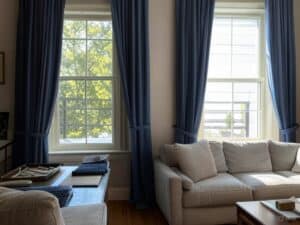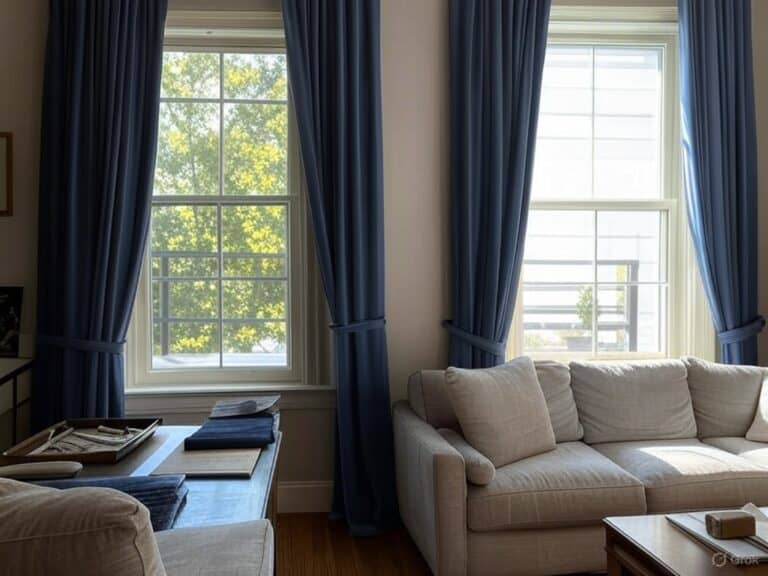I never thought much about window treatments until my buddy Dave asked me over to see his newly renovated living room. What caught my eye wasn’t his expensive couch or the art on the walls—it was the curtains.
“You made these?” I asked, running my hand over the thick, perfectly hemmed fabric.
“Tore a weekend,” he said. “Changed the whole room.”
He wasn’t exaggerating. The custom panels looked so good I wanted to do the same in my house.
Store-bought curtains never fit my odd-shaped windows leaving that big gap at the top where light sneaks in or pools on the floor like a wedding dress train.

Getting Started: Materials You’ll Need
Making your own curtains starts with gathering the right supplies. You’ll need:
- Perfect fabric for your space
- Sewing machine with matching thread
- Measuring tape
- Straight pins
- Iron for crisp seams
Last month I met an interior designer at a hardware store who told me his secret: “Always buy extra fabric, especially as a beginner. Calculate your measurements, then add 20% extra fabric. You’ll thank me later.”
My favorite curtain shopping spots aren’t the big box stores but smaller fabric shops where the staff can guide you through options.
When I mentioned my north facing bedroom windows to a shop owner in my neighborhood she immediately directed me to fabrics that would maximize the little light I get while still providing privacy.
@evarsity highlights how mastering curtain making and sewing can open doors to exciting careers in interior design, custom window treatments, and upholstery services. With the right skills, creativity meets opportunity, turning fabric into functional art and transforming homes while building a thriving business.
Discover how mastering the art of curtain making and sewing can lead to various career options, including interior design, custom window treatment businesses, and upholstery services.#sewing #CareerDevelopment #curtains #CareerGrowth #CareerAdvice #CareerSuccess #fypシviral pic.twitter.com/VJOVMKT8ft
— FinstockEvarsityCollege (@evarsity) November 5, 2024
Measuring Like a Pro
Windows are never square, something I learned the hard way. Measure the width of your window and add 8-12 inches on each side for fullness. For length decide if you want sill length or floor to ceiling drama.
My colleague Tom hung his custom drapes and they barely reached the windowsill. “Measure twice, cut once isn’t just for woodworking,” he told me with a laugh. Now he recommends measuring from the rod location to where you want the hem to fall, then adding 8 inches for the rod pocket and bottom hem.
Choosing Your Curtain Pattern
The curtain pattern you choose affects both the look and function of your window treatments. Unlined curtains let the light filter through beautifully but offer less insulation.
Lined panels provide better temperature control and privacy. When my brother moved into a street level apartment I suggested a double layer curtain system—sheer panels for daytime privacy and heavier curtains to pull closed at night. The combination turned his space from fishbowl to sanctuary.
@ElenaKihlman showcases the artistry of handmade decorative curtains using the Nuno felting technique, blending merino wool into fabric for a luxurious touch. These exquisite designs add elegance, refinement, and a unique splash of color, transforming any space into a sophisticated sanctuary.
Decorative Curtain made entirely by hand by the designer with the technique Nuno which consists of felting merino wool inside the tissue. The refined high quality design element gives to the house elegance and refinement, with a touch of extremely original color.
— Elena Kihlman (@ElenaKihlman) March 13, 2025
The designs … pic.twitter.com/O0OFpCjoT9
Step-by-Step Guide
Even with minimal sewing experience making rod pockets is easy:
- Fold and press the top edge down 1 inch
- Fold again 3 inches for a standard curtain rod
- Sew a straight line along the bottom edge of the fold
Side hems follow the same logic—fold, iron, pin, and sew in a straight line. My first attempt looked like I’d sewn it during an earthquake but even those imperfect panels looked better than anything I found in stores.
For a more professional finish consider pleater tape. An older gentleman at my local fabric store showed me how this simple addition creates perfect, evenly spaced pleats without any math.
Hanging Your Creation
The moment of truth comes when you hang your new curtains. I recommend recruiting a friend—holding panels while climbing a ladder solo is a circus act.
My proudest DIY moment was when my girlfriend saw the custom panels I made for our living room. “You sewed these?” she asked, examining the stitching. That single project turned our house into a home.
The beauty of making your own window treatments is the perfect fit—panels that hang exactly where you want, fabrics that match your decor precisely, and the quiet satisfaction of being able to point to something beautiful and say, “I made that.”
Whether you’re covering odd shaped windows, making blackout curtains for a bedroom or just wanting something uniquely yours designing your own curtains is a project worth the effort.
The fabric you choose, the pattern you select, and even the height you hang them turn your space into something no store-bought option ever could.







